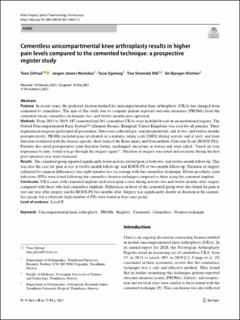| dc.contributor.author | Gifstad, Tone | |
| dc.contributor.author | Nordskar, Jørgen Jebens | |
| dc.contributor.author | Egeberg, Tarjei | |
| dc.contributor.author | Wik, Tina Strømdal | |
| dc.contributor.author | Winther, Siri Bjørgen | |
| dc.date.accessioned | 2021-10-26T07:36:08Z | |
| dc.date.available | 2021-10-26T07:36:08Z | |
| dc.date.created | 2021-06-05T21:05:35Z | |
| dc.date.issued | 2021 | |
| dc.identifier.citation | Knee Surgery, Sports Traumatology, Arthroscopy. 2021, 1-6. | en_US |
| dc.identifier.issn | 0942-2056 | |
| dc.identifier.uri | https://hdl.handle.net/11250/2825532 | |
| dc.description.abstract | Purpose In recent years, the preferred fxation method for unicompartmental knee arthroplasty (UKA) has changed from cemented to cementless. The aim of this study was to compare patient-reported outcome measures (PROMs) from the cemented versus cementless techniques two- and twelve-months post-operation. Methods From 2015 to 2019, 187 cemented and 261 cementless UKAs were included based on an institutional registry. The Oxford Unicompartmental Knee System™ (Zimmer Biomet, Bridgend, United Kingdom) was used for all patients. Three experienced surgeons performed all procedures. Data were collected pre- and peroperatively, and at two- and twelve-months postoperatively. PROMs included pain (evaluated on a numeric rating scale [NRS] during activity and at rest), and knee function (evaluated with the disease-specifc short form of the Knee injury and Osteoarthritis Outcome Score [KOOS-PS]). Patients also rated postoperative joint function (better, unchanged, uncertain or worse) and were asked, “based on your experience to date, would you go through the surgery again?”. Duration of surgery was noted and revisions during the first post-operative year were evaluated. Results The cemented group reported signifcantly lower activity-related pain at both two- and twelve-month follow-up. This was also the case for pain at rest at twelve-month follow-up, and KOOS-PS at two-month follow-up. Duration of surgery (adjusted for surgeon diferences) was eight minutes less on average with the cementless technique. Eleven prosthetic joint infections (PJIs) were found following the cementless fxation technique compared to three using the cemented implant. Conclusion UKA cases with cemented implants had lower pain scores during activity two and twelve months after surgery compared with those who had cementless implants. Diferences in favor of the cemented group were also found for pain at rest one year after surgery and for KOOS-PS two months after. Surgery was signifcantly shorter in duration in the cementless group, but a relatively high number of PJIs were found in that same group. | en_US |
| dc.language.iso | eng | en_US |
| dc.publisher | Springer | en_US |
| dc.rights | Navngivelse 4.0 Internasjonal | * |
| dc.rights.uri | http://creativecommons.org/licenses/by/4.0/deed.no | * |
| dc.title | Cementless unicompartmental knee arthroplasty results in higher pain levels compared to the cemented technique: a prospective register study | en_US |
| dc.type | Peer reviewed | en_US |
| dc.type | Journal article | en_US |
| dc.description.version | publishedVersion | en_US |
| dc.source.pagenumber | 1-6 | en_US |
| dc.source.journal | Knee Surgery, Sports Traumatology, Arthroscopy | en_US |
| dc.identifier.doi | 10.1007/s00167-021-06617-5 | |
| dc.identifier.cristin | 1913920 | |
| cristin.ispublished | true | |
| cristin.fulltext | original | |
| cristin.qualitycode | 1 | |

